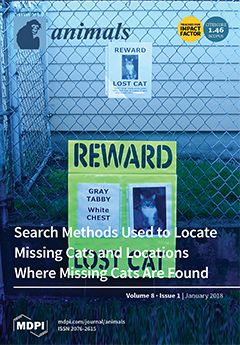Depopulation of infected poultry flocks is a key strategy to control and contain reportable diseases. Water-based foam, carbon dioxide inhalation, and ventilation shutdown are depopulation methods available to the poultry industry. Unfortunately, these methods have limited usage in caged layer hen operations. Personnel
[...] Read more.
Depopulation of infected poultry flocks is a key strategy to control and contain reportable diseases. Water-based foam, carbon dioxide inhalation, and ventilation shutdown are depopulation methods available to the poultry industry. Unfortunately, these methods have limited usage in caged layer hen operations. Personnel safety and welfare of birds are equally important factors to consider during emergency depopulation procedures. We have previously reported that compressed air foam (CAF) is an alternative method for depopulation of caged layer hens. We hypothesized that infusion of gases, such as carbon dioxide (CO
2) and nitrogen (N
2), into the CAF would reduce physiological stress and shorten time to cessation of movement. The study had six treatments, namely a negative control, CO
2 inhalation, N
2 inhalation, CAF with air (CAF Air), CAF with 50% CO
2 (CAF CO
2), and CAF with 100% N
2 (CAF N
2). Four spent hens were randomly assigned to one of these treatments on each of the eight replication days. A total of 192 spent hens were used in this study. Serum corticosterone and serotonin levels were measured and compared between treatments. Time to cessation of movement of spent hens was determined using accelerometers. The addition of CO
2 in CAF significantly reduced the foam quality while the addition of N
2 did not. The corticosterone and serotonin levels of spent hens subjected to foam (CAF, CAF CO
2, CAF N
2) and gas inhalation (CO
2, N
2) treatments did not differ significantly. The time to cessation of movement of spent hens in the CAF N
2 treatment was significantly shorter than CAF and CAF CO
2 treatments but longer than the gas inhalation treatments. These data suggest that the addition of N
2 is advantageous in terms of shortening time to death and improved foam quality as compared to the CAF CO
2 treatment.
Full article






